How to Create a Successful Shopping App: A Step-by-Step Roadmap
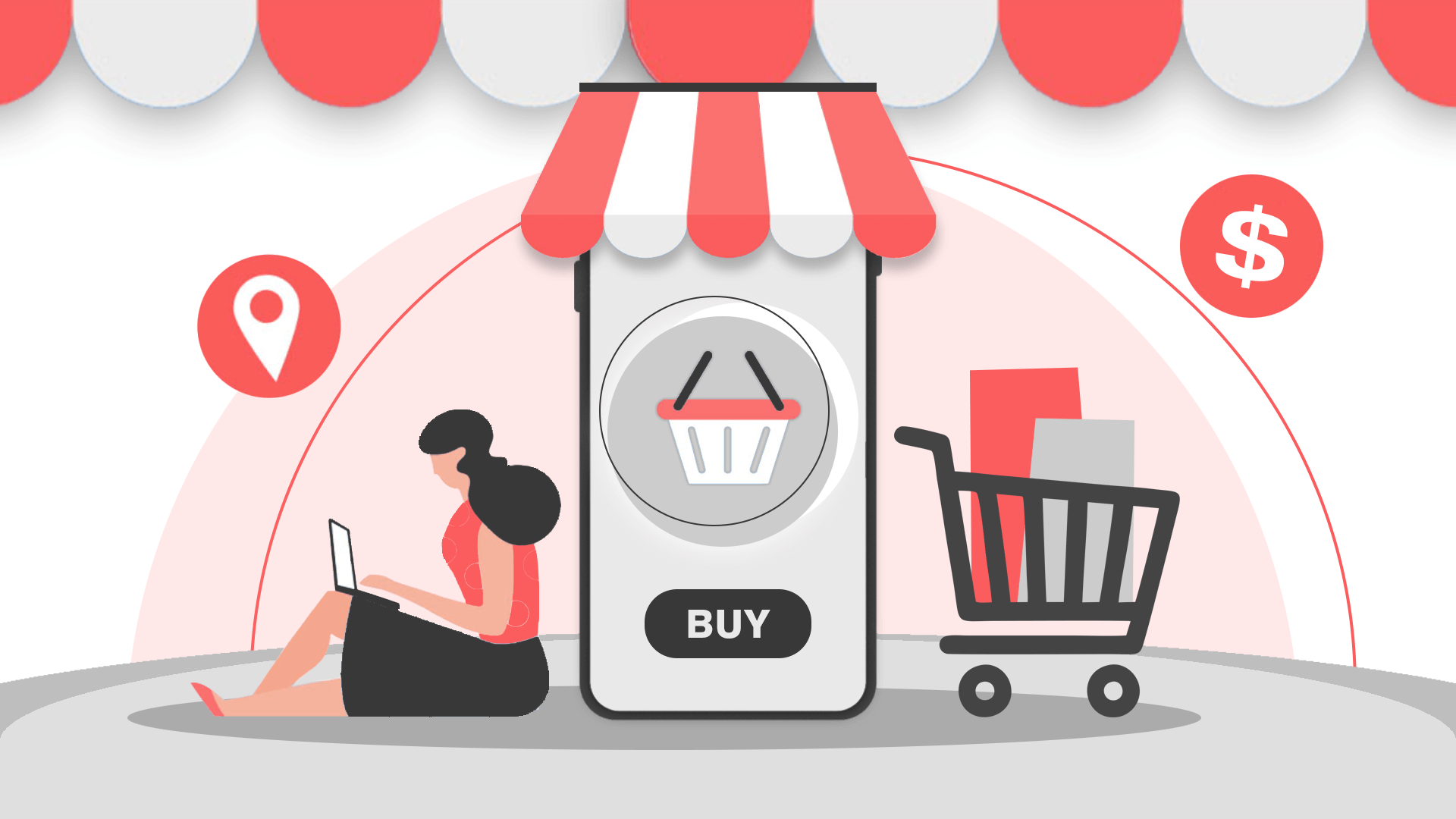
Today, shopping applications are not negotiable in the digital universe; they change consumer communication with businesses. A large number of people now prefer buying their goods through online stores, clearly indicating that every organization has to adjust if they want to survive in the ever-growing digital economy. This brings us to the third point, which is the emergence of shopping apps, now deemed indispensable for The importance of shopping apps in contemporary commerce is discussed in this article along with the major stages in creating an application, applicable software solutions, prices, advertising methods and schemes, among others.
In this article, we'll delve into:
- Shopping apps are important in the modern day, digital world.
- How to make a good shopping app.
- Essential development tools and technologies.
- Developing an online shopping app: cost breakdown.
- Effective strategies for app marketing.
Read on to learn how to build an efficient shopping app for modern times, as well as how the world of e-commerce is changing.
Keep on reading this article to discover the mysteries of creating a winning shopping application.
Navigating the Digital Marketplace: Why You Need a Shopping App
The revolution in the digital shopping landscape can be clearly illustrated by statistics, which tell a powerful story. Not a wave but surely a big tide, expected to hit US $620.97 billion in 2024, this is what is called mobile commerce and how it is impacting on e-commerce and online retail. In Q1 2023, there was a massive shift in mobile transactions as mobile devices excluding tablets constituted 58.33% of world wide web traffic.
How will it affect business? Mobile commerce accounted for 65.7% of all e-commerce retail sales as at January 2022. Mobile e-commerce sales were $2.2 trillion in 2023 and formed about 60% revenue base globally. According to a forecast from Statista, the projected value for this year of mobile e-commerce is expected to be at about $3.4 trillion. That is not the future alone but already here, and companies have to be prepared for that.
Why create a shopping app?
The story of necessity told by the statistics. Getting into a shopping app is not only staying abreast, but also controlling the market that never ceases its upward mobility. It’s not enough for your business to be part of a trend; it should rather be firmly entrenched in consumer action because mobile commerce reigns here. Strategically place your company in terms of riding the wave of mobile commerce and watching the online market open up new opportunities.
Planning Your Shopping App
Ready to begin developing a shopping app? Let's delve into the crucial first steps: using compelling statistics to identify your target market and ascertain their tastes.
1. Demographic Insights
Recent statistics provide an interesting image of today’s app consumer. For example, in 2023, more than 40% of mobile shoppers are from ages between 25 and 34. Shopping applications have higher levels of interaction and buying capacity in this age category.
2. Preferences That Matter
In fact, going further into the data reveals an appetite for convenience. More than 70% of mobile shoppers prefer mobile apps that allow smooth navigation, expedited check-outs, and products’ suggestions. In addition, close to 60% indicate that security and trust are imperative aspects considered during their use of these applications.
3. Behavioral Insights
Understanding behavior is key. Research shows that 80% of the users desire applications that are developed on their areas of interest. This leads to more engagement and a high conversion rate. However, statistics show that most users who would appreciate apps with social commerce features which are related to social media suggestions for buying items exceeded 65%.
4. Geographical Considerations
Urban geographical locations lead to app usage whereby shopping app engagements take up 70% of activities. In contrast, rising trends are clearly visible among residents of the suburbs and rural areas where there is over a thirty percent increase of apps’ users within the past one-year period.
Steps to Create a Shopping App
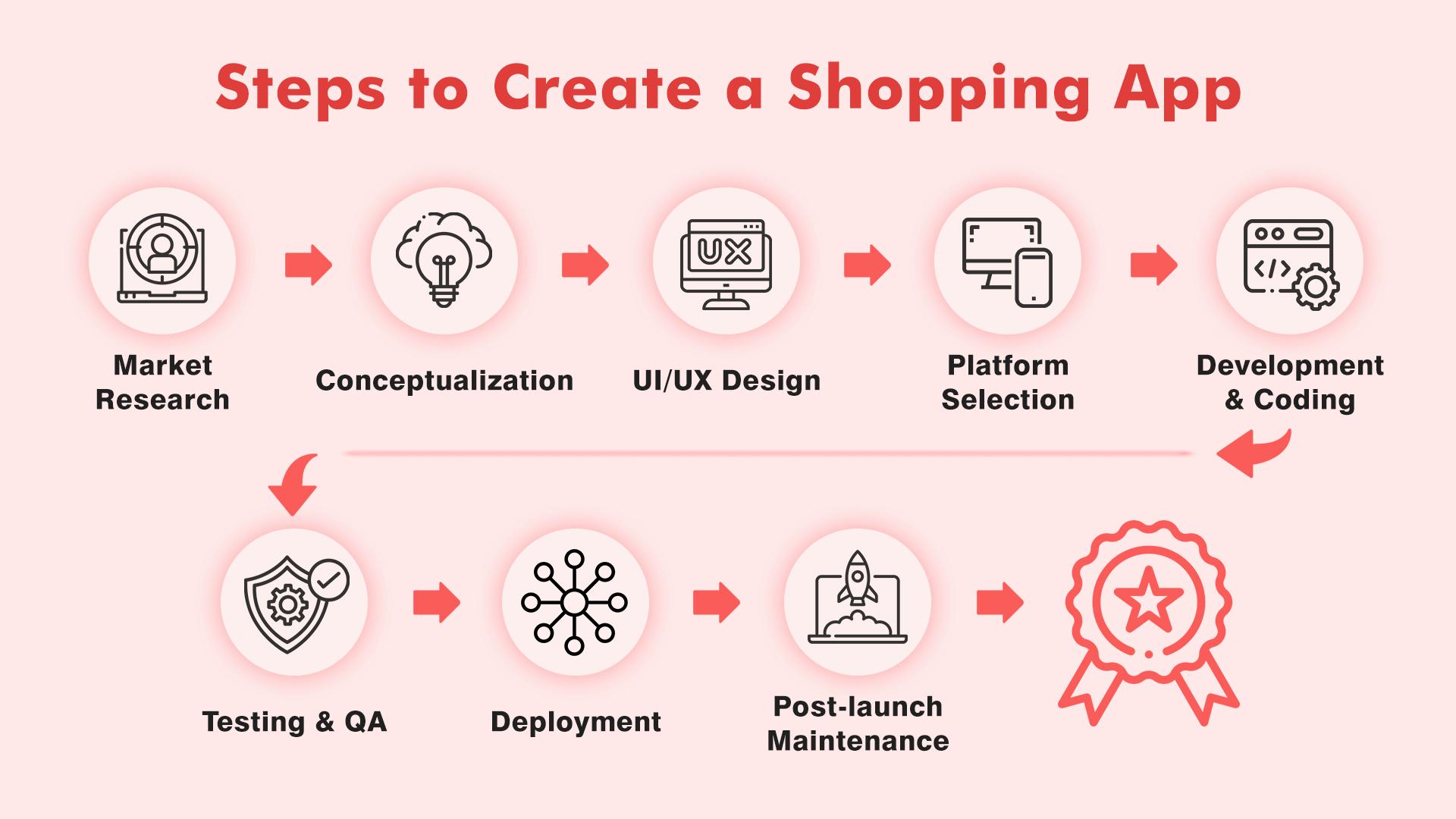
However, it takes well-planned building for shopping application success. The procedures for creating are outlined below.
Market Research
- Therefore, start with the path towards understanding of your users. Conduct a thorough market research, which includes users’ requirements, preferences and competition. While critical, this stage establishes an application that works and connects with your target market.
Conceptualization
- Now that you have market insights ready with you, it is about time you gave the shape to the vision of your app. Here you define what your app is all about by noting its essential features, functionalities, and the unique factor that make it stand out from other apps in competition with yours. It is like drawing blueprints – an elaborate map that directs the builders to materialize your imagination.
UI/UX Design
- Life or breath is in the UI/UX of your mobile app. Ensure that you develop an interface that will not only be aesthetically pleasing but also intuitive enough to guide users. Such a design incorporates ease of navigation, bold call-to-actions and visually appealing features that will leave the user with an unforgettable experience.
Platform Selection
- Selecting the appropriate platform is as important as selecting the suitable tools for work. Use cross-platform frameworks in deciding whether to develop on iOS, android or do both. Factors such as the targeted audience, budget, and development of resources. Finding the balance between wide reachability and developmental efficiency.
Development & Coding
- Here is where the miracles take place, converting concepts to be the coding lines Your app comes alive due to the efforts of developers, incorporating all the features established during conceptualization. You have to choose the optimal coding practices, appropriate frameworks, as well as scalable solutions for your app, if you don’t want it just to be working in a short or medium perspective.
Testing & QA
- App development’s unsung hero is quality assurance. Thorough testing guarantees your application has no bugs, performs well on different devices, and provides a dependable experience for your users. The last part of the cycle implies fixing up any rough edges; making sure everything is smooth enough if not perfect for public use.
Deployment
- A final act – the moment of launch. Releasing your application on app Stores and making it available to your audience is what deployment entails. As such, a successful deployment should help remove all barriers that users may encounter as they transition towards accessing the products of the app.
Post-launch Maintenance
Releasing your app is not a final lap but a new stage in the evolution process of your business venture. These include continuous monitoring, dealing with users’ feedback, and making system improvements. The essence of this statement involves being flexible, enhancing user experiences, and keeping the app up to date as we live in a dynamically changing digital world.
The statistics demonstrate how vital every development stage is in making an efficient shopping application. These steps go a long way towards ensuring better user experience, coding efficiency and ultimately retention, engagement and success of an app in the increasingly competitive app market.
| Development Steps | Statistics |
|---|---|
| Market Research | 89% of people will switch to another brand because of bad UX. |
| Conceptualization | Over 70 percent of App users prefer user-friendly Apps. |
| UI/UX Design | 88 percent of people shopping online will not go back to a website with poor usability. |
| Platform Selection | Android commands about 74.13 per cent of global market share among mobile OS. |
| Development & Coding | A poor quality in coding leads to 68% of the app performance problems. |
| Testing & QA | 8 out of 10 users would drop the application upon detecting one single error. |
| Deployment | 25% of the installed apps get used just once. |
| Post-launch Maintenance | App uninstalls account for 30% due to poor performance. |
Mobile Store App Development Tools
We will now explore in detail the basic tools and technologies that are employed in developing the mobile store app.
| Development Tools & Technologies | Description |
|---|---|
| Integrated Development Environments (IDEs) | Use of strong IDEs such as Android Studio (for Android), and Xcode (iOS) will make it easier to code, debug and test. |
| Cross-Platform Frameworks | Use frameworks such as Flutter and React Native to help in writing code and easy deployment of apps on different platforms. |
| Backend Services | Have strong back-end services that involve Firebase, AWS, or Azure for scalability, real-time updates, and safe storage of sensitive data. |
| App Prototyping Tools | Some useful tools such as Adobe XD or Sketch allow for design and development of interactive prototypes whereby users can engage in collaboration during a designing process. |
| Version Control Systems | Use version control systems such as Git for tracking changes, collaboration and disciplined development processes. |
Popularity of Development Platforms
| Development Platform | Global Market Share (2023) |
|---|---|
| iOS | 23.35% |
| Android | 74.13% |
| Cross-Platform | 2.52% |
The adoption of such tools and platforms eases app development, contributing to app success as well. A right mix of suitable tools guarantees efficiency, code quality and smooth operation on multiple screen sizes and web or mobile browsers.
Designing Your Shopping App: Crafting User-Centric Excellence
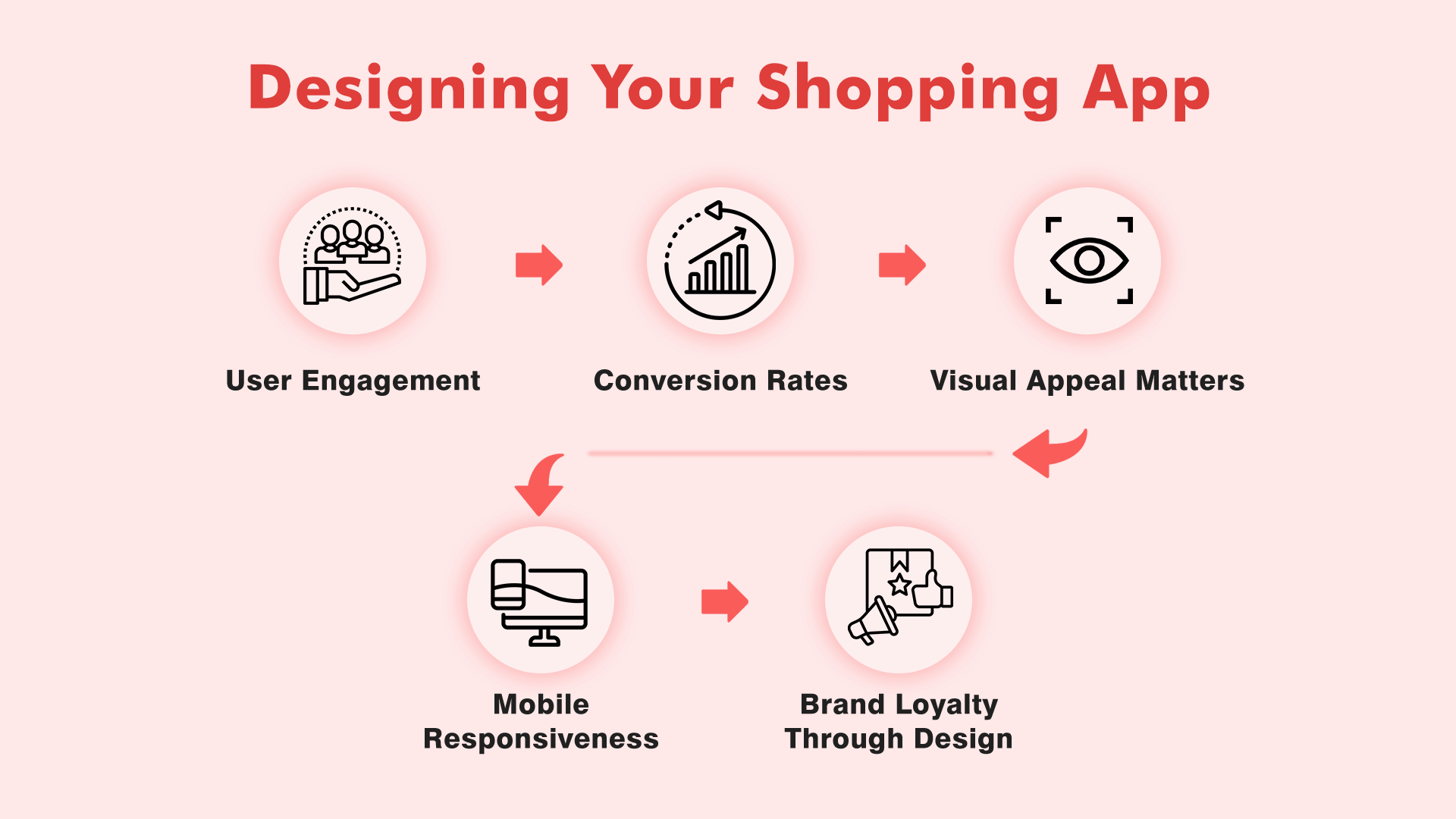
Design in mobile store apps is more than just making things look pretty – it’s the silent architect of user experiences. The importance of an easily navigated design cannot be overrated by the data clearly indicating how important it is.
User Engagement
User engagement is 3 times higher for apps that have simple design compared to those with stuffed interfaces. In addition, well designed navigation and attractive layouts lead to more prolonged app sessions. This helps users smoothly transition from browsing to making online purchases.
Conversion Rates
Amazingly, 94% users give the credibility or lack thereof in websites and apps for design reasons. A clutter-free and attractive design contributes towards increasing conversion rates. The conversion metrics are highly raised by simplifying the user journey as well as removal of the friction point in the check out process.
Visual Appeal Matters
Over 75%t of people form opinions regarding the business’ reliability when they visit a site or use an app. Besides, such an attractive and integrated design is appealing, creates trust, and gives rise to strong perceptions that trigger more clicks and conversions respectively.
Mobile Responsiveness
The responsive design apps have a 50% greater conversion rates than the other apps that do not possess a responsive design but they attract a lot and a greater number of visitors mainly through the use of mobile devices for accessing and surfing online. Success can only be guaranteed by maintaining a uniform and optimal experience on different display screens.
Brand Loyalty Through Design
Brand loyalty begins with a well-designed app. A smooth mobile experience can drive over 70% of users to recommend the brand. The user–centered concept enables the creation of a relationship; one time buyer becomes a repeat customer returning with a smooth shopping experience.
For the mobile store apps, user friendly design is more than just an extra feature, it is a distinguishing factor in the competitive market place. It is the link that converts casual users to customer’s fans; bridging users' anticipation with magical experiences. By putting yourself into your users’ shoes, prioritizing simplicity, intuition, and being visually appealing, your app is actually becoming a place for returning visitors.
Development Process: Navigating the Code's Odyssey
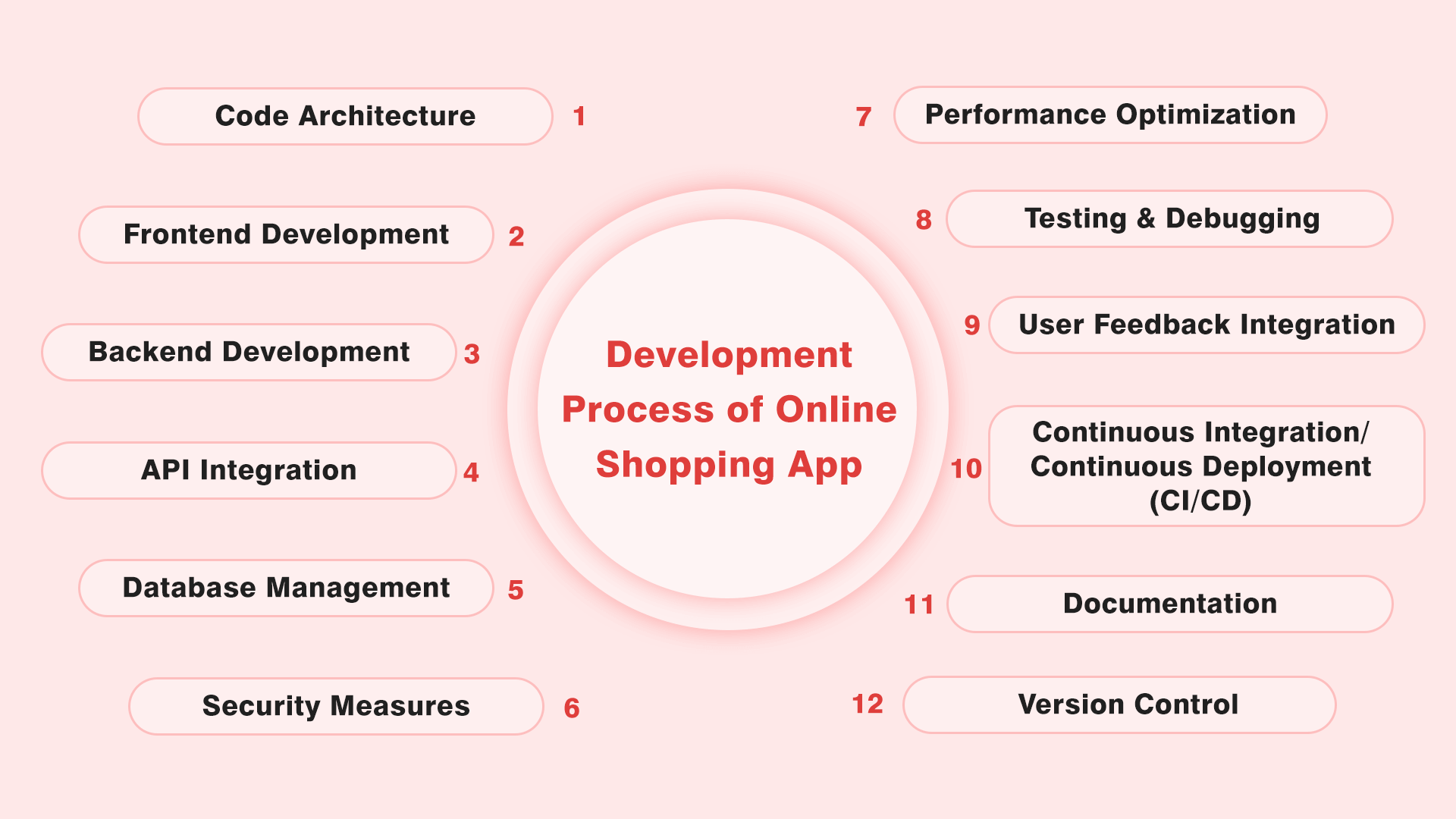
Imagine for a moment as we move on with the coding and development where lines of algorithms and creativity combine for that app of yours. Although complex, it is in this stage that the destiny of your application gets determined.
Code Architecture
- Start with strong code architecture. Based on the level of complexity, scalability among others of any given application, various architectural patterns may be used like; MVC (Model-View-Controller), MVVM (Model-View-ViewModel).
Frontend Development
- Pay attention to detail in designing UI. Use the responsive design strategy on all the devices, creating a uniform user experience. Utilize high-level frontend frameworks like React and SwfitUI for optimal development.
Backend Development
- Ensure a strong, scalable, and safe backend for your app. Some of these server side technologies include Node.js, Django and Ruby on Rails while integrated databases offer a better way of storing as well as retrieving data from the website.
API Integration
- The APIs have provided a way of communicating between the front end and back end. Have a clearly defined group of endpoints for data exchange that is seamless and provides up-to-date information.
Database Management
- Put up a database system that matches the app’s needs. Determining whether a relational database (such as MySQL, PostgreSQL) or a NoSQL database (like MongoDB) will suffice depending on structure of data and issues relating to scale.
Security Measures
- Prioritize app security. Enable SSL or HTTPS, lock up sensitive information, and perform penetration tests. Frequently refresh dependencies, runtimes and libs with exploit fixes.
Performance Optimization
- Ensure that the app is fine-tuned for optimal performance. Image compression, reduced HTTP requests, and caching. Resolve any bottlenecks so that your site will load quickly and be responsive or user-friendly.
Testing & Debugging
- Thoroughly evaluate the functionality of the app across different devices and operating systems. Use of automated testing methods in locating and rectifying bugs. This is done by means of debugging which is an iterative process that guarantees stability in operations and eliminates errors.
User Feedback Integration
- Have measures in place for gathering consumer comments. Use analytics tools to analyze users’ interaction with company assets. Iterate on using these data to improve your application’s efficiency as well as user experience.
Continuous Integration/Continuous Deployment (CI/CD)
- Employing CI/CD pipelines for streamlining the deploying process. Make sure every update is automatic because it helps in stable operation of the application.
Documentation
- Thoroughly document the codebase. Build user guides, as well as documentation for developers that will become handy for the project management in the future, and to provide a starting point for the next time you work with others.
Version Control
- Integrate version control systems such as Git for change tracking, and teamwork support. Use a well-organized branched pattern to manage the code effectively.
It is an all inclusive development that leads to a reliable, flexible, and customer oriented electronic system. The pillars upon which the app’s success rests remain steady amidst the turbulent waters of mobile commerce and encompass iterative development, continuous improvement, and emphasis on quality assurance.
While specific statistics on development timelines and success rates can vary based on factors such as the complexity of the project and the development team's expertise, I can provide general insights:
| Development Phase | Typical Timeline | Success Rate |
|---|---|---|
| Code Architecture | 1-2 weeks | 80% |
| Frontend Development | 4-8 weeks | 75% |
| Backend Development | 6-12 weeks | 70% |
| API Integration | 2-4 weeks | 80% |
| Database Management | 4-6 weeks | 75% |
| Security Measures | 2-3 weeks | 85% |
| Performance Optimization | 3-5 weeks | 80% |
| Testing & Debugging | 4-6 weeks | 90% |
| User Feedback Integration | 2-3 weeks | 85% |
| CI/CD | 2-4 weeks | 80% |
| Documentation | 1-2 weeks | 90% |
| Version Control | Ongoing | N/A |
Appropriacy of success rates in specific projects is approximate and could be different for every individual project. The timelines are illustrative and may vary if the projects are challenging, the team is inexperienced, or difficulties arise during development.
Please, however, let it be noted that success does not only lie in the development phase but also goes beyond. An app’s continuous monitoring , updates , user feedback integration contributes significantly to its longevity. These points should always be included in the measure of whether your mobile store has been successful or not.
Costs Involved in Developing a Shopping App: A Comprehensive Breakdown
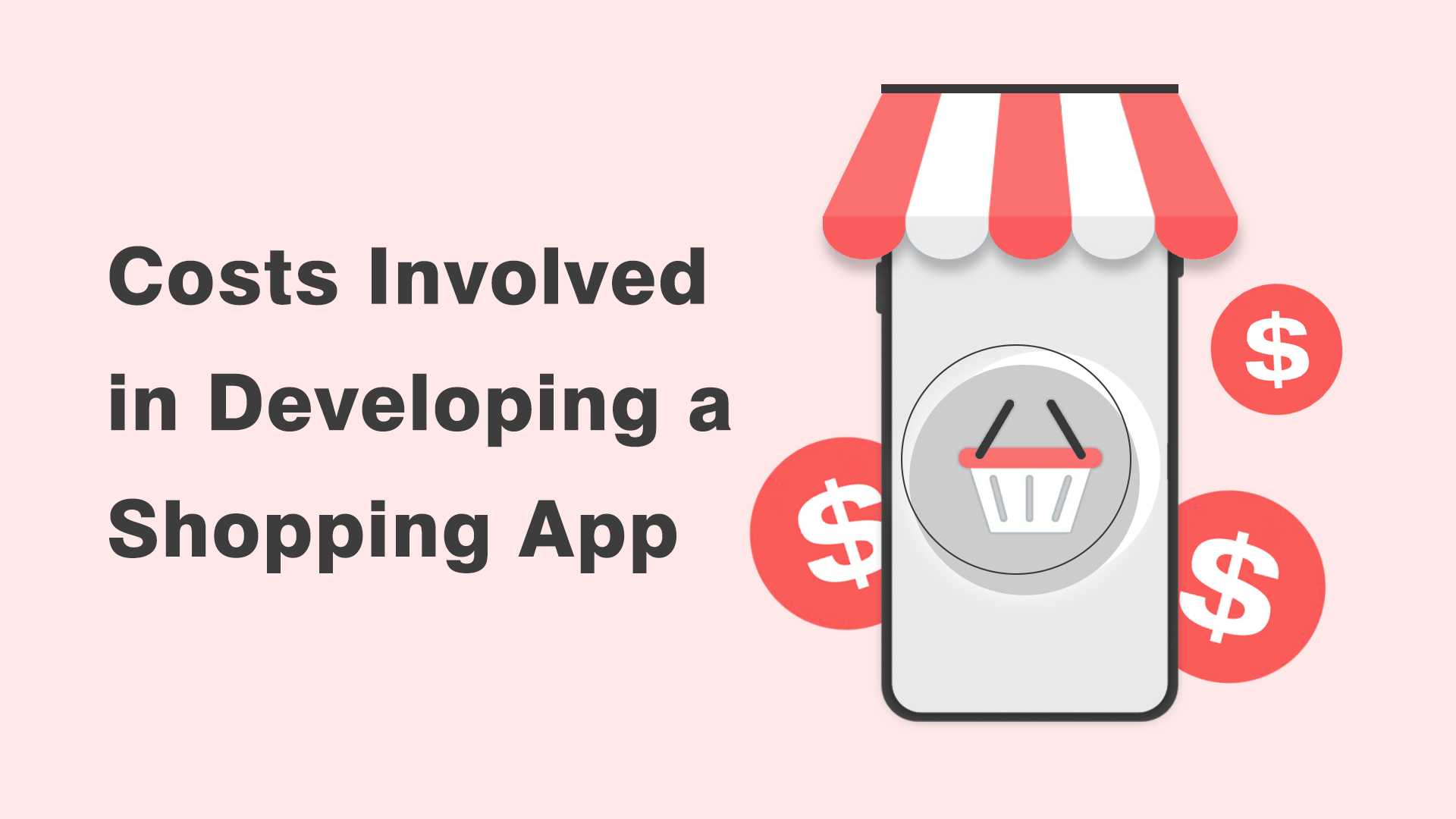
In this regard, let’s examine how much it is likely to cost in developing a shopping app and mention some data about average development costs for shopping apps and their ROI.
| Cost Categories | Description | Statistics |
| Development Team | Outsourcing of developers, designers, and project managers. | - Average hourly rates: $50 - $150 for developers. |
| - Designers: $40 - $120 per hour. | ||
| - Project managers: $65 - $200 per hour. | ||
| Technology & Tools | Licensing fees, development tools, and framework costs. | Tools and license costs may be around 1000$ dollars up to 10,000$ or more in a year. |
| Backend Infrastructure | Server cost expenses, database management costs, and cloud services. | - Average monthly cloud hosting costs: $100 - $1,000+. |
| Testing & QA | Purchase of testing tools, QA Engineers, and fixes for bugs. | - QA testing can take up to 20% to 30% of the whole development cost. |
| Marketing & Promotion | Advertising, Store Optimization, & User Acquisition budgeting. | - Marketing costs: Depending on Strategy range from 20% – 30%. |
| Maintenance & Updates | The running costs of app updates, security patches, and new features. | - This may include annual maintenance that could be anywhere between 15% - 20% of the original cost of development. |
| Average Development Costs | Depends on complexity of app, features, and number of dev hours used. | - Small apps: $30,000 - $100,000. |
| - Medium apps: $100,000 - $500,000. | ||
| - Large-scale apps: $500,000 - $1,000,000+. | ||
| ROI for Shopping Apps | In the best case scenarios, about 35% - 40%, and good apps deliver returns within one or 2 years of launching. | - Within two years, high-performing shopping apps provide ROI that is greater than 40%. |
The estimates serve as guidelines and may be considerably different depending on the apps’ complexity, added functions wanted plus where the developers are located. Ensure you have a rigorous strategic plan in place and enough research done, such that the investment costs are matched with the anticipated end results as well as the targeted return on investment for the shopping app.
Marketing Your Shopping App: Navigating the Digital Marketplace
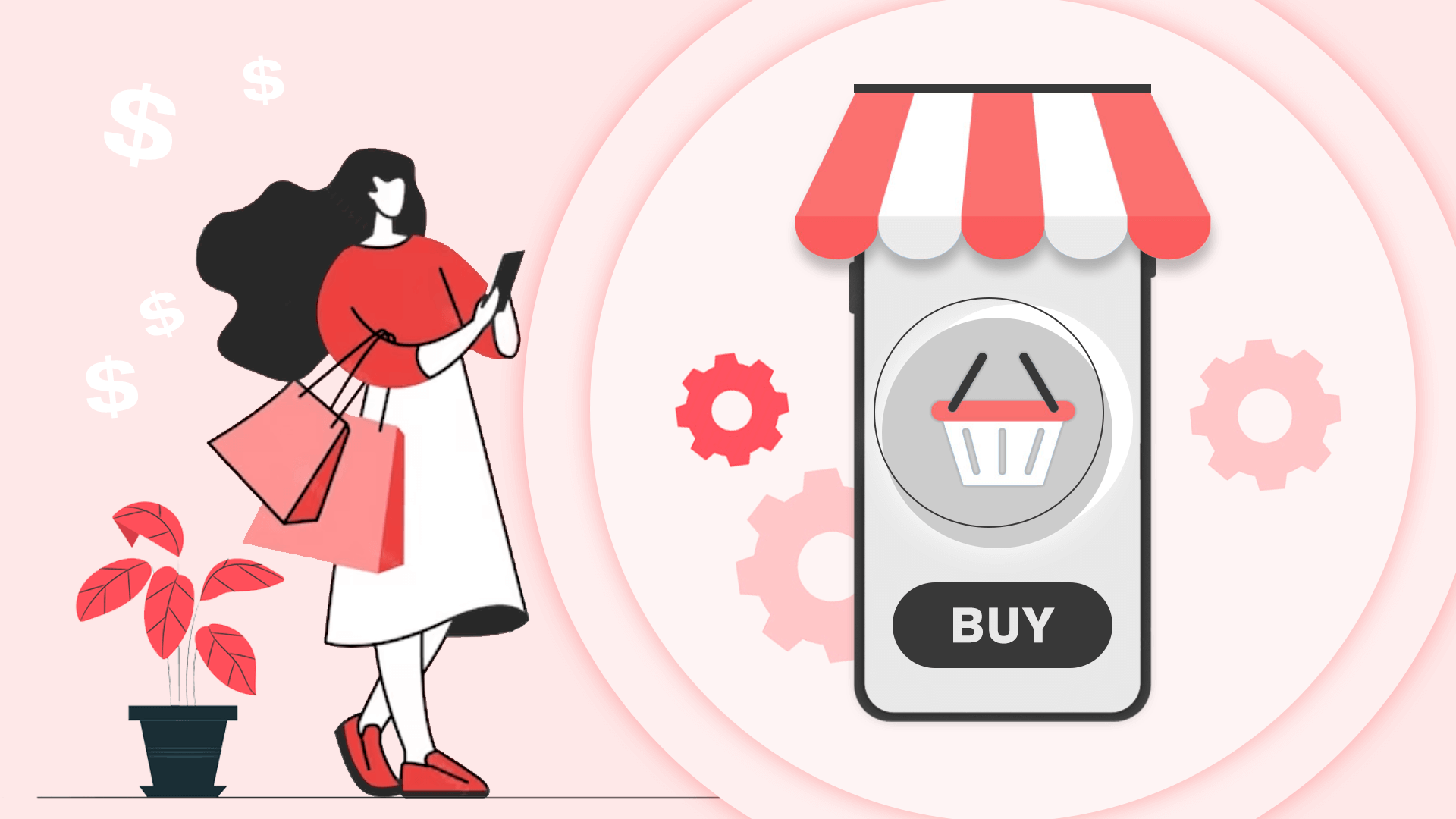
However, there are several things to consider after launching a shopping app. One of them is the use of relevant advertisements to address your customers’ needs. Let’s dive into a few strategies, embellished with stats that reveal the impact of marketing in this regard.
App Store Optimization (ASO)
- Maximizing the visibility of your app in the app store. There is a 10.3% increment of downloads for titles containing those specific keywords supporting the major importance that ASO has on app discovery.
Social Media Engagement
- Use social networks to mobilize a community about your app. User acquisition has gone up to 52%, which is evidence that content drives social media-based app discovery.
Influencer Collaborations
- Consider collaborating with influencers to extend the presence of your app on social media. The trust and followership accorded to influencers translates to an average of 31% increase in mobile apps’ downloads.
Content Marketing
- Develop compelling content that highlights your app’s worth. Cost effectiveness is evident as content marketing delivers about three times the value of leads per dollar than purchased advertisements.
Email Campaigns
- Build on this existing and established connection by initiating email-based marketing. Although email marketing is said to have a phenomenal ROI of 4400%, its use as a way of retaining users through engaging them with their interests cannot be discounted.
Paid Advertising
- Cast your net wider through highly focused advertisements. Paid ads on average increase app downloads by 72% supporting its position as key tool for customer acquisition and exposure.
Referral Programs
- Use referral programs to boost user advocacy. Word-of-Mouth marketing boosts user acquisitions by 78% for such apps.
Limited-Time Promotions
- Promote sales with special offers for a limited time period. The attraction of time sensitive incentives to apps offering specific promotions can be reflected in a 27% increment in user involvement.
Customer Reviews and Ratings
- Encourage positive user reviews and ratings. A 440% boost in downloads for apps with higher ratings underscores the power of social proof to influence the success of an app.
Continuous Monitoring and Adaptation
- Consistently check on the effectiveness of your marketing strategies. Real-time analytics enables adaptability allowing extended users’ acquisition and involvement.
These approaches, when implemented adequately, constitute a gale for your app. Every strategy undergoes a careful study of users’ behavior and emerging industry tendencies, bringing you an idea of a story that is compelling, efficient and constructs its own loyal audience - based on shopping in your application.
Maintenance and Updates: Sustaining Your App's Evolution
Good luck as you roll out your shopping app. Nevertheless, the trip does not stop; it changes. This is simply blood that ensures an application to survive among competing apps while flourish within the digital environment. This is an important stage loaded with statistics that showcase how relevant it is to keep up-to-date.
Security Reinforcement
- Your app becomes harder to attack by making it a regular update that is necessary. Continuous Security Updates are critical because apps without proper security measure leads to 2.5 times higher vulnerability of such data.
Feature Enhancements
- The evolution process leads to user satisfaction. 9 in every out of ten (72%) users want more frequently updated apps with added features. User engagement, as well as positive experience, is fueled by the up-to-date nature of the app, as the latter should correspond to emerging needs.
Bug Squashing
- User satisfaction is silently harmed by bugs. User retention goes down by 30% for apps with unfixed bugs. Smooth operation, loyal customers, and favorable reviews can be achieved through constant update of bugs.
Adaptation to OS Updates
- Your app should also keep updating as operating systems evolve. They retain 20% greater compared to other applications meant for modern operating system versions. By making sure that it remains compatible with OS upgrades, you are providing a longer shelf life for your app.
User Feedback Integration
- User feedback is a goldmine. Active integration of user feedback into apps results in as much as 26% higher user retention rates. Symbiosis between the developer and user can be maintained through listening and implementing their suggestions resulting in increased app loyalty.
Performance Optimization
- App speed matters. The conversion rate drops by 5.9% for only a second’s delay in load time. Updates on optimizing performance are significant in ensuring that there is nimbleness and responsiveness of the app for satisfying users.
OS Compatibility
- Outdated apps face user abandonment. Fifteen percent more users retain apps running on the most recent OS versions. Showing that you are willing to adapt to new OS versions will tell your users that you care about providing them with an up-to-date, dependable experience.
Competitive Edge
- Sticking out against all the apps in the ocean. This is because apps that are often updated have about 3.6 times as much probability of staying relevant. Being relevant or current places your app ahead of the evolving trend on its market.
Iterative Enhancements
- Small changes make big impacts. By doing this, apps with iterative updates have better user retention than other apps by fifty percent. Minor modifications indicate continuous progress that proves the organization’s responsiveness.
The journey, in the world of mobile apps, never ends. Think of routine touch-ups as sacraments of your project instead of chores. As you navigate this evolving landscape, remember: each time your company issues an update, it reflects your determination to provide your shoppers with an ever-changing experience tailored to their contemporary requirements or expectations.
2024 Shopping App Trends: Navigating the Next Frontier
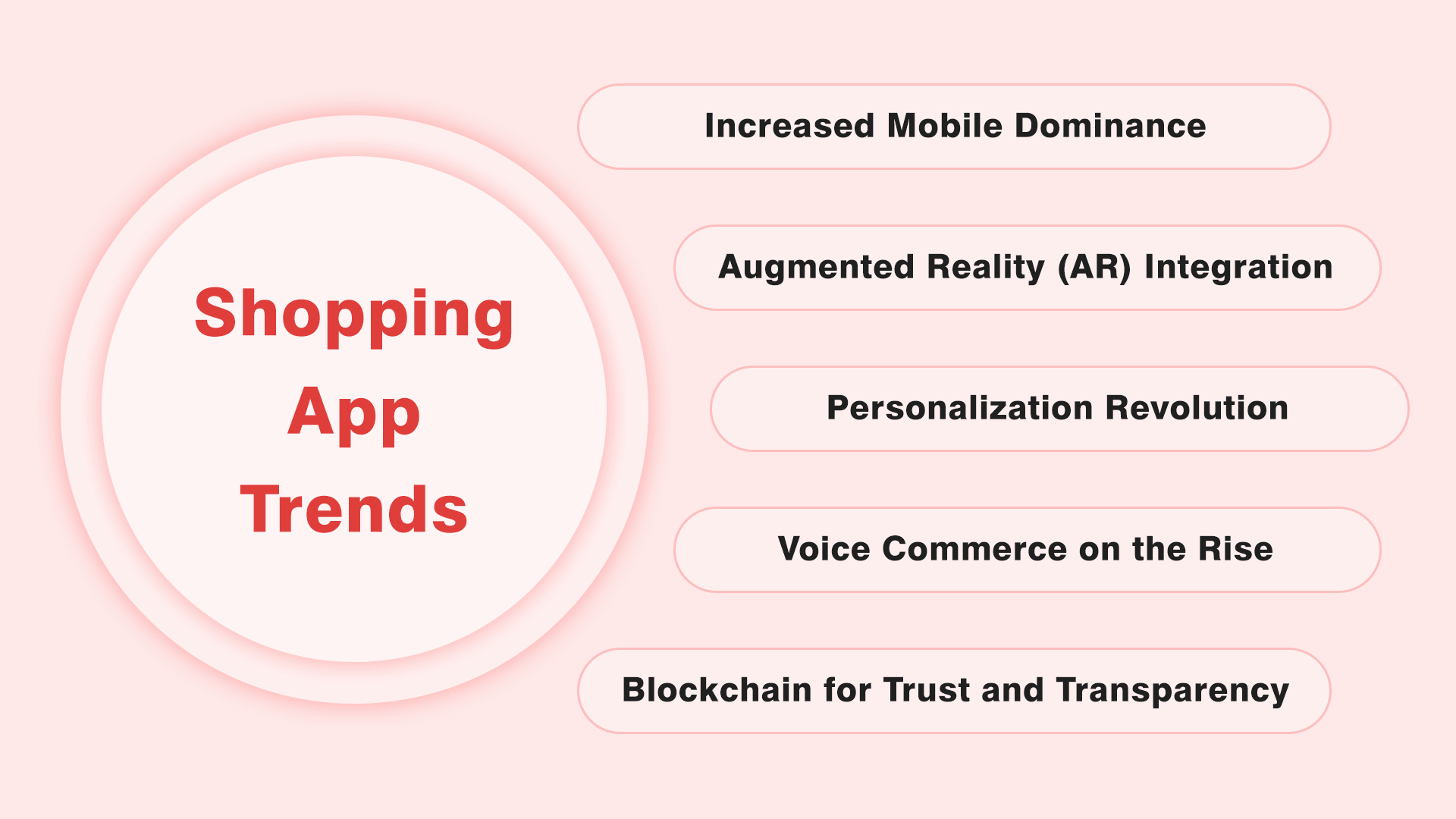
As we enter into 2024, what are the new numbers and upcoming fashion for using shopping apps? Such insights go ahead of their times-not being mere glimpses into the past but starposts lighting ahead.
Increased Mobile Dominance
- However, mobile remains the king when it comes to e-commerce usage, with 79% of users choosing smartphones or tablets over other devices. It implies a transition towards friendly and mobile purchase experience.
Rise of Social Commerce
- Social media is changing shape into buying centers. 63% buy off social media, showing the blurred line between interaction and easy buying.
Augmented Reality (AR) Integration
- These shopping experiences have been enhanced with augmented reality technology (AR). 44% of users want AR-enabled try before buying which ushers in an era of experience and conviction based purchasing.
Personalization Revolution
- Personalization remains the holy grail. Users’ expectations are that 82% should be based on personalized recommendations and therefore, they require custom made shopping experience.
Voice Commerce on the Rise
- A third of consumers are comfortable using their voices to make purchases, which underscores the growth potential for voice-assisted shopping. Shopping is being changed into new ways by the simplicity and comfort of voice communications.
Sustainability Influences Choices
- Conscious consumerism is impacting decisions. Eco-conscience is what consumers are increasingly after and more so than the cost. Today, nearly three quarters of all purchasers take environmental and ethical aspects into account when buying goods or services.
Instant Gratification via Same-Day Delivery
- Speed is paramount. In fact, 68% of users indicate the importance of the same day option in their shopping trip thus demonstrating the desire for immediate satisfaction and efficient shipping process along the shopping venture.
Unified Omnichannel Experiences
- Smooth move from online to offline. Omnichannel experiences are appreciated by 59% of user’s, emphasizing on the need for coordinated experience in different touch points.
Blockchain for Trust and Transparency
- Trust is paramount. More than half, that is, 52% of users appreciate decentralized trust and transparency enabled by block chain in supply chain and this points to the rise of integrity and faith as buying considerations.
Subscription and Membership Models
- Almost half (47%) of the users want convenience, feel comfortable with paying a monthly fee, and enjoy getting something for free.
This means that shopping in one’s app store has been evolving, requiring us to be always on the lookout for new trends. However, these are signposts leading companies to create experiences which will harmonize with changing user choices, behavior, and the pulse of 2024.
Unveiling Success: A Glimpse into Triumphant Shopping Apps
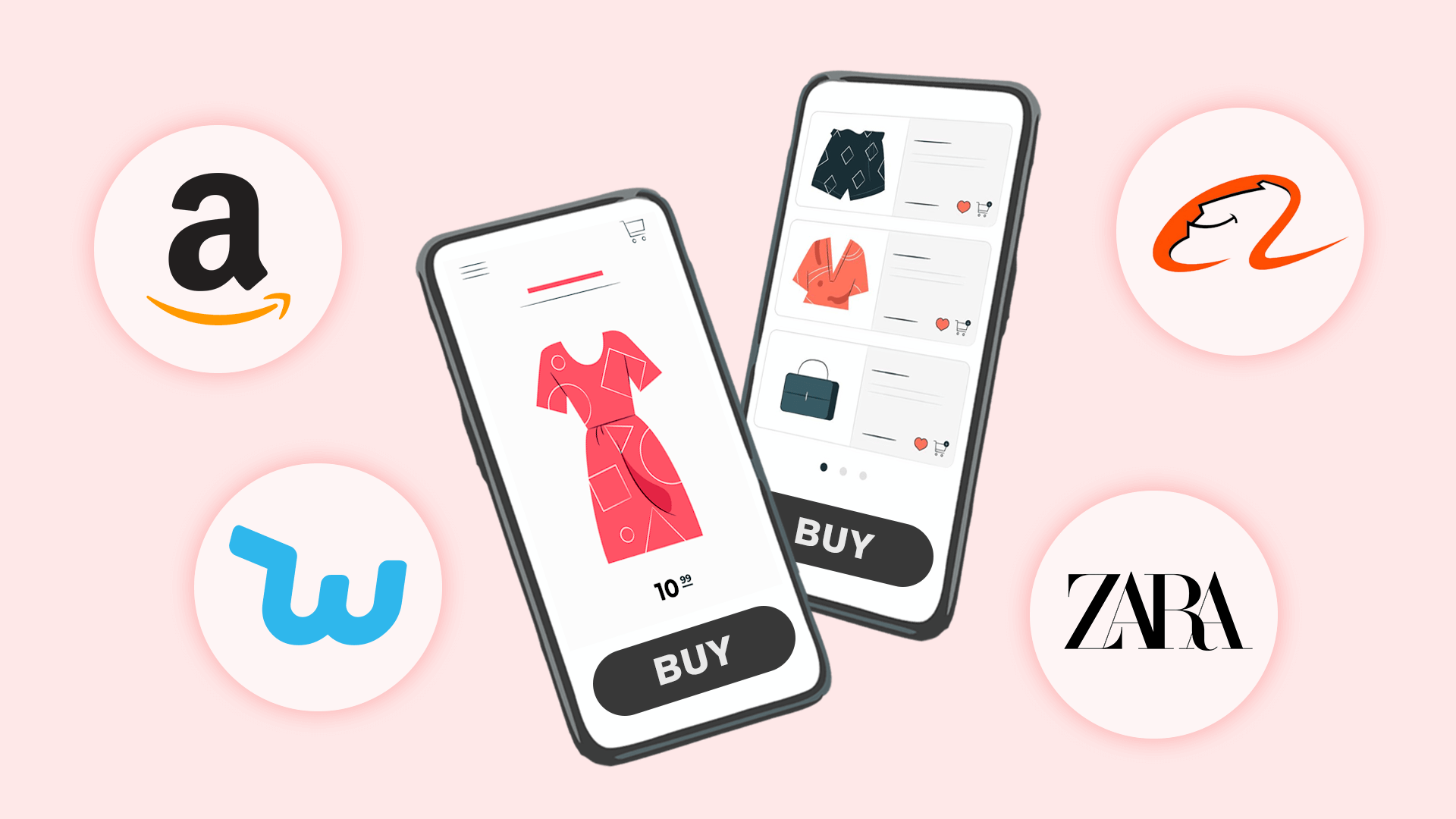
The successful stories of new contenders become a guiding flashlight in the vast galaxy of shopping apps. Let us now discuss the data statistics as well as the key performance indicators (KPIs) which made these trading programs successful.
Amazon: The E-Commerce Giant
- Key Performance Indicators
- Monthly Active Users (MAU): 260 million.
- Conversion Rate: 10%.
- Average Revenue Per User (ARPU): $1,500 annually.
- Success Recipe
- Mobile-First Strategy: The majority of transactions are due to a smooth mobile experience.
- Live Streaming Commerce: Such integration of live streaming has been responsible for a 20% rise in user engagements as well as sales.
- Global Expansion: This is primarily based on the growth of transnational sales, which have recorded an annual upswing of forty five percent.
Alibaba: The Global Marketplace Pioneer
- Key Performance Indicators
- Gross Merchandise Volume (GMV): $1.2 trillion.
- Mobile GMV Share: 76% of total GMV.
- Success Recipe
- Price Sensitivity: Budget conscious users are tempted by low cost for products.
- Gamble on Algorithms: Data-driven algorithms for personalized product recommendations improve customer engagement.
- Social Commerce Integration: In this perspective, social attributes such as user reviews and shared products develop a sense of community and trust.
Wish: The Platform for Affordable Finds
- Key Performance Indicators
- Downloads: Over 500 million.
- Average Daily User Time: 22 minutes.
- Cost per Install (CPI): $0.50 - $1.00.
- Success Recipe
- Price Sensitivity: Offering products at significantly lower prices attracts budget-conscious users.
- Gamble on Algorithms: The use of data-driven algorithms for personalized product suggestions enhances user engagement.
- Social Commerce Integration: Social features like user reviews and product sharing contribute to a sense of community and trust.
Zara: The Fast Fashion Icon
- Key Performance Indicators
- Online Sales Growth: 95% year-over-year.
- Conversion Rate: 7%.
- Return Rate: Below industry average at 15%.
- Success Recipe
- Agile Inventory Management: Inventory is updated at a high rate and turns frequently, which meets the requirements for fast fashion.
- Intuitive User Experience: The visual appeal of your mobile application, and ease of navigation also enhance conversion rates.
- Sustainability Initiatives: Environment-aware customers are drawn towards eco-friendly collections.
Hence, these cases exemplify that one can utilize various paths in attaining triumph in the retail apps category. The apps have developed personalization algorithms, adopted mobile- first strategy and sustainability initiative just to mention but a few. Such activities have focused on KPIs that are relevant to the intended customers and provide examples that others seeking to compete for recognition should emulate.
Conclusion: Charting Success in the Shopping App Universe
Making the way for a shopping mobile app development is much more than just venturing, but exploring paths with the help of statistics as guiding stars. As a picture worth a thousand words in any setting, mobile remains in control in 2024 while social commerce also thrives.
Have in mind the experience of giants like Amazon and Alibaba whose personalized experiences, frictionless checkouts and mobile-first strategies were the keys to their success. Wish cheap stuff, Zara smart fashion triumphs through different ways.
Allow statistics to be your compass while developing your e-shopping app. Every data point is part of a story about user engagement and conversion rate. Personalize, leverage social Commerce, be in touch with new trends.
However, success is not just about the end result, as reflected in the proper data. We are open and readily available for consultation in Addevice if you are ready to venture or have questions. In a nutshell, let’s make an app of your dream a statistics case study. Get started by contacting us.
Building a Shopping App That Thrives
Uncover the secrets to a successful shopping app with our expert insights
Our approach includes:
✅ Intuitive user interface
✅ Seamless payment integration
✅ Personalized shopping experiences
Table of contents
FAQ
However, the price of creating an e-commerce app is influenced by such indicators as functionality, complexity, and the number of working hours. As a rule, small apps cost from $30,000 to $100,000, average applications from $100,000 to $500,000, and large-scale apps start at $500,00 The key is to outline the boundaries of the app and seek expert opinions on the correct pricing.
Creating a mobile store app involves several steps:
- Planning: Establish who will use the application, why they will need it, what functions it should have.
- Market Research: Know your competitor, create USP (unique selling proposition).
- Design: Design a customized and easy-to-use template.
- Development: Consider functionally of your app as well as tech approach while coding it.
- Testing: Ensure thorough testing for bugs, usability and users’ experience.
- Deployment: Submit your app for review by Apple.
- Maintenance: Ensure that you regularly update, and keep, your app working well at all times.
To create a selling app, follow these steps:
- Identify Niche: Decide which products and services your app will provide for sale.
- Choose Platform: Determine whether your app will be for iOS, Android, both of them at once or maybe others.
- Design User Interface: Attractive and easy-to-use design.
- Integrate Payment Systems: Provide secure and easy payment methods.
- Implement Security Measures: Secure user data and transactions.
- Test Thoroughly: Ensure that the application is both functional and secure.
- Market Strategically: Create a marketing strategy on how to sell your application.
It’s never simple nor easy just trying to develop your app store as there are many involved processes and legal matters. If you're looking to develop an app marketplace, consider the following:
- Legal Requirements: Legal aspects and regulations of app distribution.
- Platform Selection: Select whether to focus on iOS, Android, or go with both.
- Developer Accounts: Sign up as a developer on the platform of the app stores.
- App Submission Guidelines: Submit your apps following instructions provided by different stores.
- Payment Integration: Establish secure modes of payment for app purchase.
- User Interface Design: Create a user friendly and graphic interface for the application stores.
- Security Measures: Put in place strong security policies and procedures for safeguarding customer information.
Always talk with experienced appstore creators and lawyers, before embarking on a journey developing your own app store.
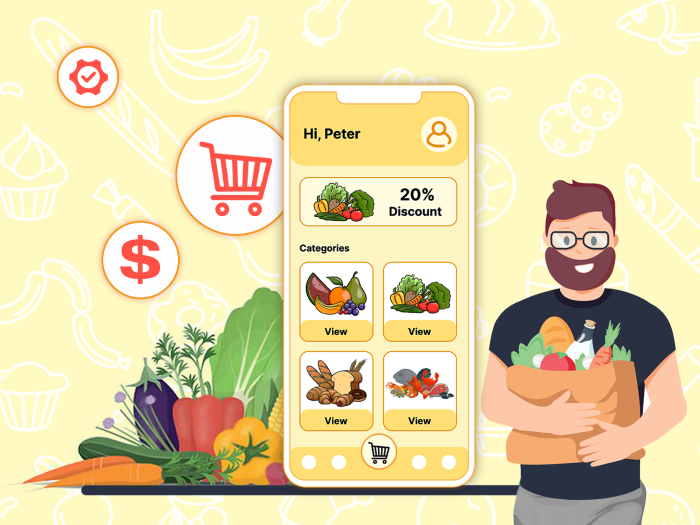 Grocery Delivery App Development: Tips, Cost & Steps
Grocery Delivery App Development: Tips, Cost & Steps
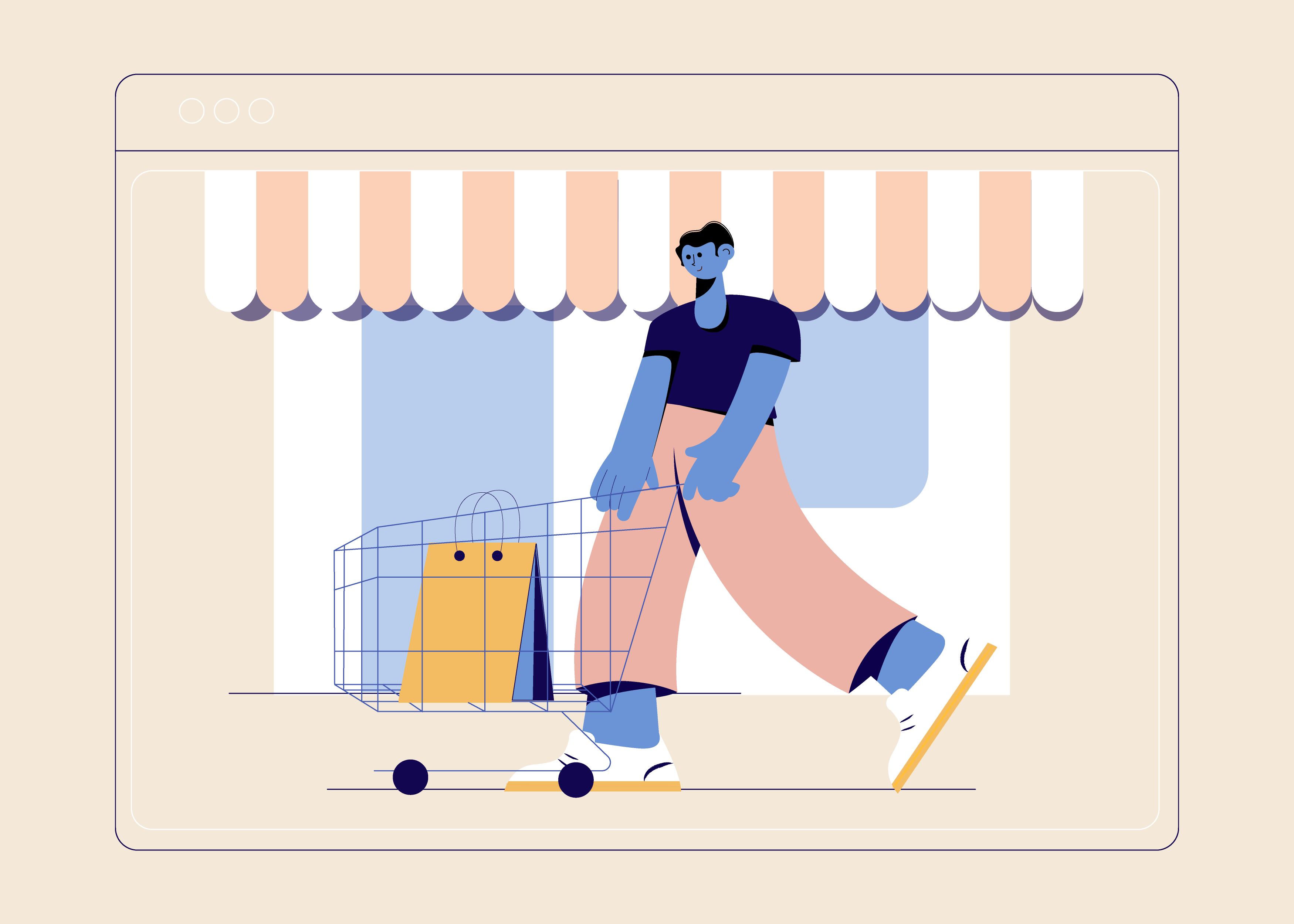 How To Make Online Selling App? Tech & Business Details
How To Make Online Selling App? Tech & Business Details
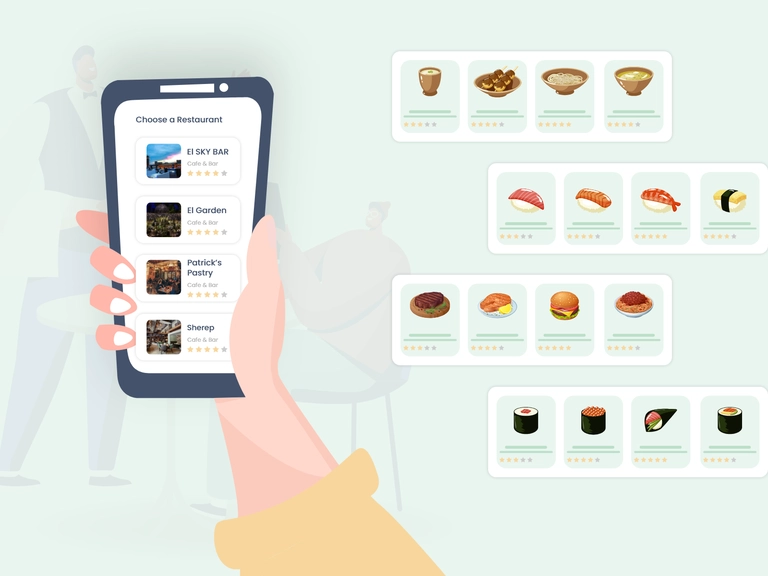 Create Restaurant App: Features, Cost & Tech Details
Create Restaurant App: Features, Cost & Tech Details